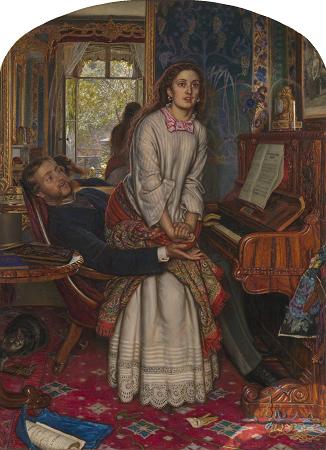Charles West Cope (1811 - 1890). Charles West Cope was an English, Victorian era painter of genre and history scenes, and an etcher. He was responsible for painting several frescos in the House of Lords in London. Cope was born at Park Square in Leeds, the son of Charles Cope, a watercolour landscape painter and art teacher. He was given the name West after that of a celebrated painter, Benjamin West, and his only sister Ellen, given the middle-name Turner, after J. M. W. Turner-both painters being friends of his father. His mother was a gifted amateur artist in watercolours who died shortly after Charles' birth. Charles was sent as a child to a boarding school in Camberwell, London, and afterwards to Terry's school at Great Marlow, where he was bullied and his elbow broken, which left him with a crooked arm for life. He then went to Leeds Grammar School, where he suffered from the attentions of a cruel teacher. In 1827, Cope's father was killed in a stage coach accident. That same year he entered Sass's Academy in Bloomsbury, London, and in 1828 became a student of the Royal Academy. He earned a silver medal from the Society of Arts in 1829, a second medal in the Royal Academy Life School, and therefore a life studentship. While at Sass's he established life-long friendship with Francis Cary and Charles Stonhouse. About 1830 he lived at lodgings in Great Russell Street, Bloomsbury close to the British Museum. In 1832 Cope went to Paris and practiced his art by copying Old Masters at the Louvre such as Titian, Rembrandt and others. In 1833 he exhibited at the Royal Academy for the first time-a picture called The Golden Age. In September of the same year he travelled to Italy, where he spent two years-earning a living for part of the time by painting pictures on commission. His painting The Firstborn was completed in Florence and exhibited at the British Institution. After returning to England, Cope took lodgings in Newman Street, London, then moved to 1 Russell Place, where his landlord and family became his artist's models. Here he painted Paolo and Franceses and Osteria di Campagna, which were exhibited at the Royal Academy in 1837 and 1838 respectively, and sold shortly thereafter for a considerable sum. In 1839-40 he painted a large altar-piece for St George's Church, Leeds, which was exhibited at the Royal Academy in 1840. Cope founded an artists' society called The Etching Club which included artists such as William Holman Hunt, Richard Redgrave and Samuel Palmer. The club published several books of etchings illustrating various themes by well-known authors such as Goldsmith's The Deserted Village, Sonnets by Shakespeare and Milton's L'Allegro and Il ponseroso. On 1 September 1840, Cope married Charlotte Benning, the daughter of a surgeon with a large country practice. They lived first in rented furnished lodgings in Lisson Grove, London, then moved to a house in Kensington in 1841. In that same year his painting Poor Law Guardians: Board-day application for bread was exhibited at the Royal Academy. Cope submitted designs for a competition to decorate the interior of the Houses of Parliament. In 1843, his drawing The First Trial by Jury earned him a prize of 300 pounds. In 1844 he submitted a further design called Meeting of Jacob and Rachel, and was one of the six painters commissioned in July of that year to prepare preliminary drawings, coloured sketches, and specimens of fresco painting for the decoration of the House of Lords. He also received 400 pounds for his design of Prince Henry Acknowledging the Authority of Judge Gascoigne. Cope received a commission to execute this design in fresco, and also another of Edward the Black Prince receiving the Order of the Garter. These commissions, and others, engaged Cope in fresco painting in the House of Lords for several years. He was also elected an associate of the Royal Academy in 1843. In 1848 he became a Royal Academician after exhibiting a large work Cardinal Wolsey's Reception at Leicester Abbey. In this year he was engaged on the frescos of Griselda and Lara on the wall of the upper waiting hall of the House of Lords. In 1849 he exhibited a painting The First-born which was subsequently engraved for the Art Union of London. In that year he travelled to Italy and Germany to improve his knowledge and technique of fresco painting. He visited Peter von Hess in Munich, who was working on a fresco in the Basilica of St. Boniface In 1850, Cope showed King Lear and Cordelia at the RA, and, in 1851, The Sisters, and Laurence Saunders's Martyrdom. In 1852, he painted the Marriage of Griselda and in 1853, Othello relating his Adventures to Dessdemona.
more...













